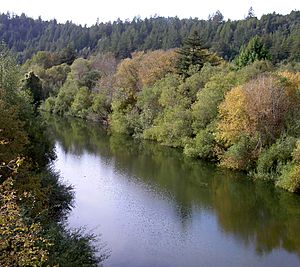Austin Creek facts for kids
Quick facts for kids Austin Creek |
|
|---|---|

Austin Creek in November 2009
|
|
|
Location of the mouth of Austin Creek in California
|
|
| Country | United States |
| State | California |
| Region | Sonoma County |
| City | Cazadero, California |
| Physical characteristics | |
| Main source | The Cedars (Sonoma County, California) 13 mi (20 km) west of Healdsburg, California 1,965 ft (599 m) 38°37′50″N 123°7′48″W / 38.63056°N 123.13000°W |
| River mouth | Russian River 1 mi (2 km) north of Duncans Mills, California 23 ft (7.0 m) 38°28′0″N 123°3′0″W / 38.46667°N 123.05000°W |
| Basin features | |
| Tributaries |
|
Austin Creek is a stream that flows for about 16.0-mile (25.7 km) through the mountains of western Sonoma County, California. It eventually flows into the Russian River. This meeting point is only about 4 miles (6 km) from the Pacific Ocean.
Contents
Where Austin Creek Flows
Austin Creek starts in a special, isolated area called The Cedars. This spot is about 13 miles (21 km) west of Healdsburg, California.
The creek flows south, passing by Layton Mine. It then enters a wooded canyon. Here, it meets King Ridge Road and soon after, Bearpen Creek joins it. Austin Creek follows King Ridge Road all the way to the town of Cazadero.
It continues south, and two more creeks, East Austin Creek and Kidd Creek, flow into it. Finally, Austin Creek passes under State Route 116. It then flows into the Russian River, about 1 mile (1.6 km) north of Duncans Mills.
History of the Area
In the late 1800s, a railroad called the North Pacific Coast Railroad (NWP) was built. It extended its tracks along Austin Creek. This was done to move lumber from Cazadero to other places. Later, this old railroad path became a road known as Cazadero Highway.
The Sonoma Magnesite Company and Mining
The Cedars is a unique forest where special trees grow on a type of rock called ultramafic rock. In 1912, a company called Sonoma Magnesite Company started mining here. They were looking for a mineral called magnesite.
Magnesite is very important for making steel. It's also used to create special bricks that can handle very high temperatures. Mining in The Cedars was expensive because of transportation costs. But during World War I, it became harder to get magnesite from other places. So, mining in The Cedars became worthwhile.
To move the magnesite, a special railway was built in 1914. It was called the Sonoma Magnesite Tramway. This narrow-gauge railway was 11 miles (18 km) long. It ran along East Austin Creek. The tramway connected the mine to a station on the NWP railroad south of Cazadero.
About 30 tons of ore were heated daily in a special oven called a kiln. The finished magnesite was then put into sacks for shipping. Mining stopped in 1920 when magnesite became available from cheaper sources again.
The Sonoma Magnesite Tramway's Trains
The railway used small 4-wheel flatcars to ship the sacks of magnesite. Each flatcar was about four feet wide and seven feet long. They could carry up to 5 tons of magnesite! Oil for the kiln was carried in six large tank cars. These were eight feet long and held 500 gallons each.
The trains were pulled by some interesting locomotives:
| Name | Builder | Type | Notes |
|---|---|---|---|
| The Hippo | Joshua Hendy Iron Works of Sunnyvale, California | 0-4-0 | This engine was new and ran on gasoline. |
| Betsy | Davenport Locomotive Works | 0-4-0ST | This steam locomotive was bought used from Washington. |
| This was a highway truck with special wheels. It could run on the tracks! |
In 1921, a big flood in East Austin Creek washed away parts of the tramway. The locomotive Betsy was even washed downstream and partly buried! Most of the tracks were removed by 1925. The kiln was taken apart in 1937.
About 1,000 feet (300 m) of track was left for a while. Children on the Baldwin estate near Austin Creek used it for fun. But another flood in 1955 destroyed that track too. Betsy was finally turned into scrap metal in 1961.
Wildlife and Discoveries
As of 2000, Austin Creek and its main smaller creeks were home to steelhead trout. These are a type of fish that live in both fresh and saltwater. Austin Creek and East Austin Creek also had California freshwater shrimp.
In 2016, scientists made an exciting discovery at The Cedars. They found tiny living things called methane-producing microbes in the water coming from underground. These microbes are special because they can thrive in harsh environments. It was the first time these types of microbes were found outside the ocean floor!
Bridges Over Austin Creek
Many bridges cross Austin Creek. The longest one is part of California State Route 116. This bridge is 380 feet (120 m) long and was built in 1962.
See Also


